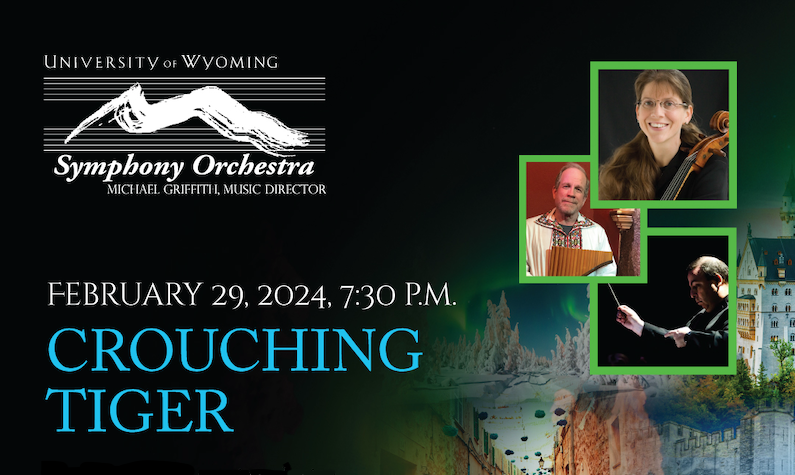Crouching Tiger Concerto
Published April 12, 2024
Everybody loves a night at the symphony. It is a chance to get out, listen to great music, support local musicians, and expand your musical horizons. On February 29, I had the chance to see the University of Wyoming Symphony Orchestra’s (UWSO) Crouching Tiger Concerto performance. This program shared the concert’s theme of playing unconventional orchestra pieces, or pieces not typically heard.
The concert started with the overture to Giuseppe Verdi’s La Forza del Destino, translating to “the force of destiny.” Verdi is one of Italy's most famous opera writers and La Forza del Destino is his most melodramatic work, twisting love scenes with scenes of murder, and ending with the main character throwing himself off of a mountain side. This theme has a constant sense of unease, foreboding mixed with lush, romantic melodies. Then playing the title piece of the concert, UWSO performed Tan Dun’s Crouching Tiger Concerto featuring the University of Wyoming’s very own Beth Vanderborgh playing cello. From the 2001 movie Crouching Tiger, Hidden Dragon, the Crouching Tiger Concerto is a cello concerto composed of six movements, and uses many advanced techniques, unconventional sounds, and traditional Asian flutes. Finishing off the concert, UWSO then played Symphony No. 2 "Song of a New Race" by William Grant Still. Known as the “dean of African-American composers,” Still was a member of the Harlem Renaissance and contributed his own take on modern classical music. Within this four-movement work, we hear many variations of classical melodies mixed with blues, jazz, echoes of spirituals, jazz harmonies, and bits of popular rag-time.
The Crouching Tiger Concerto was one of the central pieces of the concert. Written by Tan Dun, the piece is rich in lush, Chinese harmonies. Dun is a Chinese-born conductor and composer. He is known for drawing a wide range of influences into his work, specifically traditional Western works and Chinese influences and melodies. He composed the score for Crouching Tiger, Hidden Dragon and later arranged selected tracks into the cello concerto. The film Crouching Tiger, Hidden Dragon is adapted from the fourth novel in a five-book series, serialized in 1941-42. The story takes place during the Qing dynasty in China. Dun actively takes themes from the history and novel for to create the soundtrack. The concerto consists of six movements: I “Crouching Tiger, Hidden Dragon,” II “Through the Bamboo Forest,” III “Silk Road: Encounters,” IV “Eternal Vow,” V “To the South,” and finally VI “Farewell.” Dun originally wrote the Crouching Tiger Concerto for legendary Chinese-American cellist, Yo-Yo Ma.
Throughout the concerto’s various movements, a lot of alternative or non-traditional techniques are used. For example, the cello is often hit or struck like a percussion instrument, rather than bowed traditionally. The cello is also strummed and played like a guitar. In addition to these extended techniques on cello, the percussion also uses unique methods to get varying sounds. Featured prominently throughout the piece is the use of tars, a technique from North Africa. This involves placing a cymbal upside down on the timpani head and struck by a string bow. In doing this the cymbal vibrates and the timpani head vibrates sympathetically. The timpani are then pedaled to slide between pitches, creating a haunting sound that has been compared to whales communicating underwater.

To further continue adding to the Chinese elements of music, Dun originally wrote the piece for traditional Asian flutes. Guest artist and UW professor emeritus, Rod Garnett, enhanced the performance by playing the bawu, shakuhachi, Indian bansuri, and the Chinese dizi—all small traditional flutes, some crafted by bamboo and wood.
Throughout this performance, it was incredibly fascinating to hear traditional Asian instruments and melodies in contemporary Western symphonic work. Typically, Western symphonic work focuses on polyphonic compositions. This means that multiple parts are playing and working towards an overall texture in the piece. While melody still exists, it is not always the sole focus. Our ears are a lot more adapted to hearing this kind of harmony. Chinese music differs in a lot of ways. Melodies are created by using a different arrangement of notes, while Western music mostly has two modes; major and minor, and only uses whole tones and halftones. Chinese music is not only built on whole tones and half tones, but also smaller tones such as 1/4 tones and 1/7 tones, and can thrive off of improvisation. This offers a captivating experience, and is unlike a lot of music heard in Wyoming. While Western musical literature is extremely important to learn and familiarize, typically Chinese music and melodies are not often heard here.
I believe it is incredibly important to hear melodies and instruments from all over the world, and to be familiar with composers from all backgrounds and areas of the world. Unearthing the depths of foreign orchestral music, I hope to continue to get to hear this kind of music being performed, and to further understand and be exposed to foreign music.


